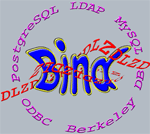The DLZ stub driver is included only for testing the functionality of the (S)DLZ API. It should NOT be used in a production environment.
Be sure to specify --with-dlz-stub when running configure so that the stub driver is built with BIND. By default DLZ and its drivers are not built. When you specify a DLZ driver the DLZ core is automatically built too.
To use the DLZ stub driver, add syntax similar to the following to your named.conf file.
dlz "dlz_stub_zone" {
database "dlz_stub example2.com web 10.5.5.6";
};
|
Here's the breakdown of the syntax:
| dlz | Indicates to BIND that you wish to use a (S)DLZ driver in this view. |
| dlz_stub_zone | The name displayed if an error occurs while named.conf is parsed. |
| database | Required. It is a required DLZ option. Everything enclosed in double quotes is the DLZ command line. This is parsed and passed to the driver. |
| dlz_stub | The name of the driver to use. In this case, we are using the DLZ stub driver. |
| example2.com | The first parameter after the driver name. The DLZ stub driver expects a zone name here. |
| web | The second parameter after the driver name. The DLZ stub driver expects an "A" record name here. |
| 10.5.5.6 | The last parameter. The DLZ stub driver expects an IPV4 IP address here. |
The DLZ stub driver is very simple and does not perform any parameter checking, so be sure to use it properly. It is not intended for production use. (I mean really, production use of this driver would be really silly!) It is only meant to demonstrate the use of and exercise the (S)DLZ API.
Once you have added this to your named.conf file, BIND will answer queries for "web.example2.com" with "10.5.5.6".

